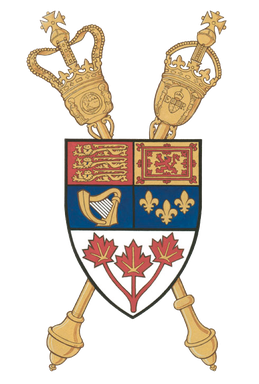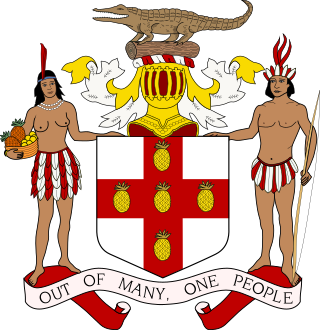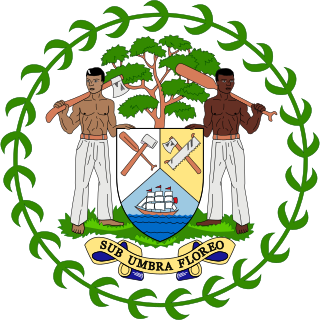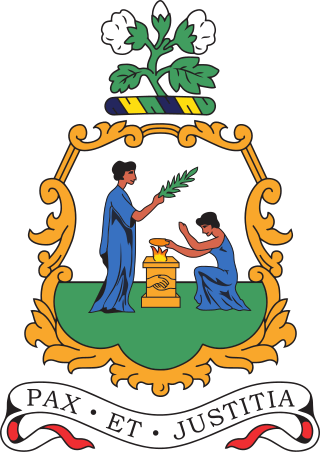Related Research Articles

The Westminster system, or Westminster model, is a type of parliamentary government that incorporates a series of procedures for operating a legislature, first developed in England. Key aspects of the system include an executive branch made up of members of the legislature, and that is responsible to the legislature; the presence of parliamentary opposition parties; and a ceremonial head of state who is separate from the head of government. The term derives from the Palace of Westminster, which has been the seat of the Westminster Parliament in England and later the United Kingdom since the 13th century. The Westminster system is often contrasted with the presidential system that originated in the United States, or with the semi-presidential system, based on the government of France.

The monarchy of Canada is Canada's form of government embodied by the Canadian sovereign and head of state. It is one of the key components of Canadian sovereignty and sits at the core of Canada's constitutional federal structure and Westminster-style parliamentary democracy. The monarchy is the foundation of the executive (King-in-Council), legislative (King-in-Parliament), and judicial (King-on-the-Bench) branches of both federal and provincial jurisdictions. The current monarch is King Charles III, who has reigned since 8 September 2022.

The Parliament of Canada is the federal legislature of Canada, seated at Parliament Hill in Ottawa, and is composed of three parts: the King, the Senate, and the House of Commons. By constitutional convention, the House of Commons is dominant, with the Senate rarely opposing its will. The Senate reviews legislation from a less partisan standpoint and may initiate certain bills. The monarch or his representative, normally the governor general, provides royal assent to make bills into law.

A Commonwealth realm is a sovereign state that has Charles III as its monarch and head of state. All the realms are equal with and independent of the others, though one person, resident in the United Kingdom, acts as monarch of each. The phrase Commonwealth realm is an informal description not used in any law.

A speech from the throne, or throne speech, is an event in certain monarchies in which the reigning sovereign, or their representative, reads a prepared speech to members of the nation's legislature when a session is opened. The address sets forth the government's priorities for its legislative agenda, for which the cooperation of the legislature is sought. The speech is often accompanied by formal ceremony. It is often held annually, although in some places it may occur more or less frequently, whenever a new session of the legislature is opened.
The style and title of the Canadian sovereign is the formal mode of address of the monarch of Canada. The form is based on those that were inherited from the United Kingdom and France, used in the colonies to refer to the reigning monarch in Europe. As various Canadian territories changed ownership and then the country gradually gained independence, the style and title of the monarchs changed almost as often as the kings and queens themselves. The mode of address currently employed is a combination of a style that originates in the early 17th century and a title established by Canadian law in 2024.

The Crown is the state in all its aspects within the jurisprudence of the Commonwealth realms and their subdivisions. The term can be used to refer to the office of the monarch or the monarchy as institutions, to the rule of law, or to the functions of executive, legislative, and judicial governance and the civil service.
King-in-parliament is a constitutional law concept used within Commonwealth realms that refers to the Crown in its legislative role, acting with the advice and consent of the parliament. Bills passed by the houses are sent to the sovereign or their representative, for royal assent in order to enact them into laws as Acts of parliament. An Act may also provide for secondary legislation, which can be made by executive officers of the Crown, although subject to the simple approval or dissallowance by parliament.

His Majesty's Loyal Opposition, or simply the Official Opposition, is usually the second-largest party in the House of Commons. Typically, it is the largest party of the parliamentary opposition, which is composed of members of Parliament (MPs) who are not in government.

The monarchy of New Zealand is the constitutional system of government in which a hereditary monarch is the sovereign and head of state of New Zealand. The current monarch, King Charles III, acceded to the throne following the death of his mother, Queen Elizabeth II, on 8 September 2022 in the United Kingdom. The King's elder son, William, Prince of Wales, is the heir apparent.
Canadian royal symbols are the visual and auditory identifiers of the Canadian monarchy, including the viceroys, in the country's federal and provincial jurisdictions. These may specifically distinguish organizations that derive their authority from the Crown, establishments with royal associations, or merely be ways of expressing loyal or patriotic sentiment.

Elizabeth II was proclaimed queen throughout the Commonwealth after her father, King George VI, died in the early hours of 6 February 1952, while Elizabeth was in Kenya. Proclamations were made in different Commonwealth realms on 6, 7, 8, and 11 February. The line of succession was identical in all the Commonwealth realms, but the royal title as proclaimed was not the same in all of them. Accession was followed sixteen months later by the Coronation of Elizabeth II at Westminster Abbey in London on 2 June 1953.

The monarchy of Canada forms the core of each Canadian provincial jurisdiction's Westminster-style parliamentary democracy, being the foundation of the executive, legislative, and judicial branches of government in each province. The monarchy has been headed since September 8, 2022 by King Charles III who as sovereign is shared equally with both the Commonwealth realms and the Canadian federal entity. He, his consort, and other members of the Canadian royal family undertake various public and private functions across the country. He is the only member of the royal family with any constitutional role.

The monarchy of Jamaica is a system of government in which a hereditary monarch is the sovereign and head of state of Jamaica. The current Jamaican monarch and head of state, since 8 September 2022, is King Charles III. As sovereign, he is the personal embodiment of the Jamaican Crown. Although the person of the sovereign is equally shared with 14 other independent countries within the Commonwealth of Nations, each country's monarchy is separate and legally distinct. As a result, the current monarch is officially titled King of Jamaica and, in this capacity, he and other members of the royal family undertake public and private functions domestically and abroad as representatives of the Jamaican state. However, the monarch is the only member of the royal family with any constitutional role.

The monarchy of Belize is a system of government in which a hereditary monarch is the sovereign and head of state of Belize. The current Belizean monarch and head of state since 8 September 2022, is King Charles III. As sovereign, he is the personal embodiment of the Belizean Crown. Although the person of the sovereign is shared with 14 other independent countries within the Commonwealth of Nations, each country's monarchy is separate and legally distinct. As a result, the current monarch is officially titled Kingof Belize and, in this capacity, he and other members of the royal family undertake public and private functions as representatives of the Belizean state. However, the King is the only member of the royal family with any constitutional role.

The monarchy of Barbados was a system of government in which a hereditary monarch was the sovereign and head of state of Barbados from 1966 to 2021. Barbados shared the sovereign with the other Commonwealth realms, with the country's monarchy being separate and legally distinct. The monarch's operational and ceremonial duties were mostly delegated to her representative, the governor-general of Barbados.

The monarchy of Grenada is a system of government in which a hereditary monarch is the sovereign and head of state of Grenada. The current Grenadian monarch and head of state, since 8 September 2022, is King Charles III. As sovereign, he is the personal embodiment of the Grenadian Crown. Although the person of the sovereign is equally shared with 14 other independent countries within the Commonwealth of Nations, each country's monarchy is separate and legally distinct. As a result, the current monarch is officially titled King of Grenada and, in this capacity, he and other members of the royal family undertake public and private functions domestically and abroad as representatives of Grenada. However, the King is the only member of the royal family with any constitutional role.

The monarchy of Saint Vincent and the Grenadines is a system of government in which a hereditary monarch is the sovereign and head of state of Saint Vincent and the Grenadines. The current Vincentian monarch and head of state, since 8 September 2022, is King Charles III. As sovereign, he is the personal embodiment of the Vincentian Crown. Although the person of the sovereign is equally shared with 14 other independent countries within the Commonwealth of Nations, each country's monarchy is separate and legally distinct. As a result, the current monarch is officially titled King of Saint Vincent and the Grenadines and, in this capacity, he and other members of the royal family undertake public and private functions domestically and abroad as representatives of Saint Vincent and the Grenadines. However, the King is the only member of the royal family with any constitutional role.
The phrase His Majesty's Government is a formal term referring to the government of a Commonwealth realm or one of its constituent provinces, states or territories. In use since at least the height of the British Empire, the phrase has been inherited and integrated into the countries that emerged from that polity and which remain Commonwealth realms.

Elizabeth II was Queen of Sierra Leone from 1961 to 1971, when Sierra Leone was an independent constitutional monarchy. She was also the monarch of other Commonwealth realms, including the United Kingdom. Her constitutional roles in Sierra Leone were mostly delegated to the governor-general of Sierra Leone.
References
- 1 2 3 Schmitz, Gerald (December 1988), The Opposition in a Parliamentary System, Ottawa: Queen's Printer for Canada, archived from the original on 21 March 2015, retrieved 28 October 2009
- 1 2 Durkin, Mary; Gay, Oonagh (8 February 2006), Her Majesty's Opposition (PDF), Westminster: Queen's Printer, p. 2, SN/PC/3910, archived from the original (PDF) on 27 March 2009, retrieved 28 October 2009
- ↑ Ignatieff, Michael (2012), Ibbitson, John (ed.), "Michael Ignatieff's timely warning on the politics of fascism", The Globe and Mail (published 30 October 2012), retrieved 30 October 2012
- 1 2 Durkin & Gay 2006 , p. 1
- ↑ Elizabeth II (11 December 2008), Legislative Assembly Act, 1, Edmonton: Alberta Queen's Printer, retrieved 28 October 2009